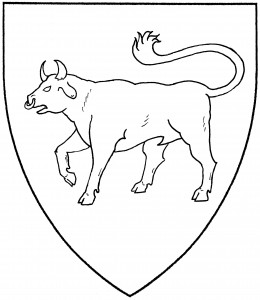This beast is the male bovine, noted for its size, strength, and temper. The term here includes such bovines as the “ox”, the “steer”, and the “bison” or “buffalo”; though the buffalo is usually drawn with larger horns (as in the arms of Desenberch or Wezenborg, d.1393 [Gelre 53]), the exact term is often chosen for the sake of a cant. As a charge, the bull dates from at least c.1370, in the arms of von Plessen [Gelre 100v]; in mundane armory, it is often drawn with a ring through its nose, even when this is not explicitly blazoned.
There is also the “cow”, the female bovine, drawn with prominent udders; and the “calf”, the young bovine, drawn without horns (as in the canting arms of Vele, 1275 [ANA2 166]). Finally, Society armory includes the “yak”, the hairy wild bull of Asia.
None of the bovine family seems to have a default posture; the illustration shows a bull passant. See also pelt.
The Baron of Stierbach bears: Per fess embattled argent and gules, three bulls courant counterchanged, that in base within a laurel wreath argent.
Eadmund de Tonge of Arkengarth bears: Pean, a bull passant to sinister argent.
Angus Murdoch Stewart bears: Argent, a cow rampant purpure within a bordure gules.
Clifford of York bears: Or, a yak statant guardant sable armed argent.
